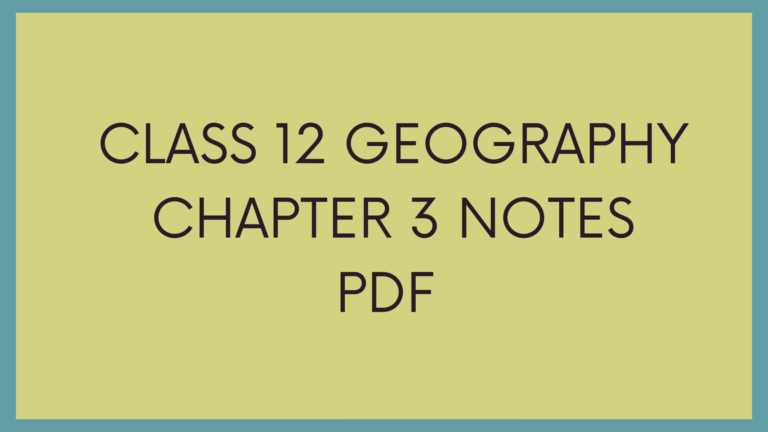Class 11 Geography Chapter 1 Notes | Geography as a Discipline Important topics and Notes
This article will provide you with the Class 11 Geography Chapter 1 Notes. Geography is a very important topic for students in class 11. They need to study it properly. So, I have prepared the handwritten style notes for them, which they can use easily.
Chapter 1: Geography as a Discipline from Fundamentals of Physical Geography (Class 11 NCERT).

Class 11 Geography Chapter 1 Notes
Introduction
- Geography = study of Earth as the home of humans and other living beings.
- Word Geography comes from Greek words:
- Geo = Earth
- Graphos = Description
- First used by Eratosthenes (276–194 BC), a Greek scholar.
- Simple meaning → “Description of the Earth.”
Geography tells us what is where, why it is there, and how it changes over time.
Why Study Geography?
- We live on Earth → our life depends on surroundings.
- Early humans → dependent on plants, animals, land, water.
- With technology → humans modified environment, used resources better.
- Geography helps us:
- Understand natural & cultural variations.
- Learn maps & modern tools (GIS, GPS, Remote Sensing).
- Appreciate diversity of people & places.
- See human–nature interactions.
What is Geography?
- Definition (simple): Geography = description & explanation of Earth’s surface.
- Richard Hartshorne: Geography is the study of areal differentiation.
- Hettner: Geography studies differences of phenomena in different parts of Earth.
💡 Geography = not just “what & where” → but also “why” phenomena happen.
Nature of Geography
- Geography is:
- Integrating discipline (brings together natural + social sciences).
- Spatial science (studies distribution & location).
- Science of cause–effect (why things vary).
- Physical & human environment are dynamic (always changing).
Questions Geography Asks
- What? – Identification (e.g., which crops grow).
- Where? – Distribution (e.g., in which regions).
- Why? – Cause–effect (e.g., why rice in east India, wheat in north India).
Geography became scientific only when “why” was added.
Geography as an Integrating Discipline
- Geography = connects Natural Sciences (Geology, Meteorology, Botany, etc.) + Social Sciences (History, Economics, Sociology, Political Science).
- History = temporal synthesis (changes with time).
- Geography = spatial synthesis (changes across space).
- Example:
- Himalayas = barrier but passes → invasion routes.
- Seacoast = encouraged trade & cultural contacts.
📚 Approaches to Study Geography
Systematic Approach (General Geography)
- Introduced by Alexander Von Humboldt (1769–1859).
- Studies phenomena worldwide, then identifies patterns.
- Example: Studying vegetation globally → rainforests, monsoon forests, coniferous forests.
Regional Approach
- Introduced by Karl Ritter (1779–1859).
- Studies all phenomena in one region in detail.
- Example: Studying India as a region → relief, climate, agriculture, population together.
Dualism in Geography
- From the beginning, geography showed two sides (dualism):
- Physical Geography 🌋 (land, climate, water, soil).
- Human Geography 👥 (population, culture, settlements).
Branches of Geography
A) Physical Geography
- Geomorphology → Landforms, evolution, processes.
- Climatology → Atmosphere, weather, climate types.
- Hydrology → Water (oceans, lakes, rivers).
- Soil Geography (Pedology) → Soil types, fertility, use.
B) Human Geography
- Social/Cultural Geography → Society & culture.
- Population & Settlement Geography → Population growth, migration, rural & urban settlements.
- Economic Geography → Agriculture, industry, trade, tourism, transport.
- Historical Geography → Historical processes in spatial organisation.
- Political Geography → Boundaries, elections, international relations.
Biogeography (Interface)
- Plant Geography 🌱 → Vegetation patterns.
- Zoo Geography 🐘 → Distribution of animals.
- Ecology/Ecosystem 🌳 → Habitat & relationships.
- Environmental Geography 🌍 → Environmental problems (pollution, land degradation, conservation).
D) Regional Geography
- Based on regions → Macro, Meso, Micro.
- Includes:
- Regional Studies
- Regional Planning (town planning, rural planning)
- Regional Development
Philosophy & Methods in Geography
- Philosophy:
- Geographical Thought
- Human–Nature Interaction (Human Ecology)
- Methods & Techniques:
- Cartography (Manual & Computer)
- Statistical Techniques
- Field Surveys
- GIS, GPS, Remote Sensing
Importance of Physical Geography
| Sphere | Elements | Importance |
|---|---|---|
| Lithosphere | Landforms, relief | Base for human activities → agriculture, minerals, forests. |
| Atmosphere | Weather & climate | Controls house types, clothing, crops. |
| Hydrosphere | Oceans, rivers, lakes | Provides water, fish, minerals, navigation. |
| Biosphere | Plants, animals, humans | Food chain, ecological balance. |
- Physical Geography helps in:
- Understanding resources.
- Planning for sustainable development.
- Solving issues like pollution, climate change.
Human–Nature Interaction
- Primitive societies → fully dependent on nature.
- With technology → humans modified nature.
- Example:
- Soil → humans made cups, bricks.
- Night → humans created lamps.
- Today → Humanised Nature & Naturalised Humans.
- Geography studies this interaction.
Table: Physical vs Human Geography
| Physical Geography | Human Geography |
|---|---|
| Studies natural features. | Studies human activities. |
| Examples: Landforms, climate, rivers, soils. | Examples: Population, settlements, trade. |
| Deals with Lithosphere, Atmosphere, Hydrosphere, Biosphere. | Deals with society, economy, politics, culture. |
Table: Systematic vs Regional Approach
| Systematic Geography | Regional Geography |
|---|---|
| By Humboldt | By Karl Ritter |
| Studies one phenomenon worldwide. | Studies all phenomena of one region. |
| Example: World rainfall patterns. | Example: Geography of India. |
🧾 Summary Points
- Geography = description of Earth.
- It studies natural + human features and their interactions.
- It asks → What, Where, Why.
- Geography = integrating discipline (links natural & social sciences).
- Systematic & Regional approaches are main study methods.
- Dualism → Physical vs Human Geography.
- Branches → Physical, Human, Biogeography, Regional.
- Modern tools → GIS, GPS, Remote Sensing.
- Physical Geography = crucial for resource management & sustainability.
Class 11 geography Chapter 1 MCQ | Geography as a Discipline Important MCQ







One Comment